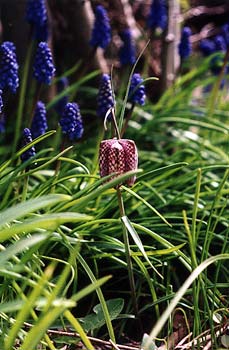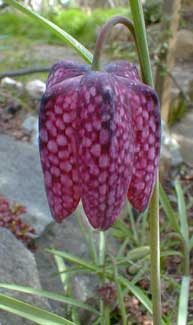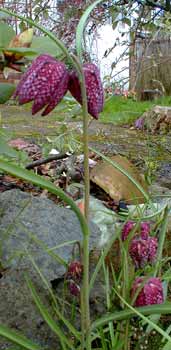 Checkered Lily
Checkered Lily
"On sunless days in winter, we shall know
By whom the silver gossamer is spun,
Who paints the diapered fritillaries,
On what wide wings from shivering pine to pine the eagle flies."
-Oscar Wilde
(1854-1900)
(1854-1900)
When Oscar Wilde speaks of "the diapered fritillary,' he means the little Checkered Lily (Fritillaria meleagris), for "diapered" is a very old traditional term for either a checkered pattern or the pattern known as "harlequin" or a checkerboard of diamonds.
By the last week of March or the first week of April the Checkered Lilies are poking up their bizarre checkerboard flowers, adding a bit of oddity to such early spring flowers as muscaris, early daffodils, & squill.
They are spotted rising their dangling flowers above the heads of the brightest blue grape hyacinths, & along a rockery ledge overshadowed by a rohani beach. Granny Artemis had gotten about fifty checkered lily bulbs (circa 2001) which were put in crevices & unusual places, so they were poking up all over in unexpected corners.
 More have been added here & there in years since, because they look good in just about any sunny spot, & a garden can't have too many. They show themselves above short groundcovers, plus there's a patch of them standing at the foot of an akebia trellis alongside the deck.
More have been added here & there in years since, because they look good in just about any sunny spot, & a garden can't have too many. They show themselves above short groundcovers, plus there's a patch of them standing at the foot of an akebia trellis alongside the deck.The first two photos on this page are from April 2003; the third is from March 2004. You can see a couple more of them on the Saxifraga 'Triumph' page.
The bell-flowers which lend them the alternate name Missionbells begin early spring & a few will still be with us late spring. It naturalizes by self-seeding. They are small enough not to be a distraction but beautiful & odd enough to simply delight.
They are also known as Guinea Hen Flowers because the checkerboard pattern resembles the patterning on guinea hens, for which reason the species name meleagris means guinea fowl. The genus name means "Dicing Box" & it is easy to imagine a wicker-woven dicebox with just such an appearance as these dangling flowers.
 Another name occasionally attached to it is Snake's Head Frittillary or Snakehead Lily, because the blossom, before the bud is fully opened, reminds some of a striking cobra. It was sometimes associated with death, & Vita Sackville-West declared it to be "a sinister little flower, in the mournful colour of decay." This is certainly not what I see in it, but those who imagined this flower to be serpenty & sinister lent it such common names as Deathbell, Madam Ugly, Widow's Veil, Snakeflower, Toadheads, Weeping Frits, Sullen Ladies, Drooping Tulips, & other such downcast-sounding titles.
Another name occasionally attached to it is Snake's Head Frittillary or Snakehead Lily, because the blossom, before the bud is fully opened, reminds some of a striking cobra. It was sometimes associated with death, & Vita Sackville-West declared it to be "a sinister little flower, in the mournful colour of decay." This is certainly not what I see in it, but those who imagined this flower to be serpenty & sinister lent it such common names as Deathbell, Madam Ugly, Widow's Veil, Snakeflower, Toadheads, Weeping Frits, Sullen Ladies, Drooping Tulips, & other such downcast-sounding titles.They were also formerly called Lazarus Bells again associated with death, or Leopard Lilies, but these names were corruptions of Lazar's Bells or Lepers' Lilies, because the shape & markings of the flowers were suggestive of leprosy, while the overall shape of the flower was reminscent of the bells attached to the clothing of beggar-lepers to announce their arrival or warn of their presence. This antique association with lepers & leprosy would seem to be the half-remembered reason for their association with death, since there's nothing in their beautiful appearance that would otherwise explain mistaking them for sinister.
As one of the longest-cultivated fritillaries, it was a regular feature in Elizabethan gardens. They were formerly known as Narcissus caperonius or Caperon's Narcissus because they were first brought to England in 1572 by a druggist named Noel Caperon who found them in France. Caperon was afterward a victim of the St. Bartholomew Day Massacre in 1578. For many years thereafter they were thought originally to have been native primarily of France, but were eventually discovered to be a rare species native also to England.
The checkered lily was once in fact native of damp meadows throughout Northwestern Europe, but is today disappearing over much of its natural range from habitat loss & humanity's population intrusions. It became endangered in England, where children picked them before they could complete their reproductive cycle. It is now protected & making a slow comeback in the south of England. And it will never be extinct for as long as people love them in gardens.